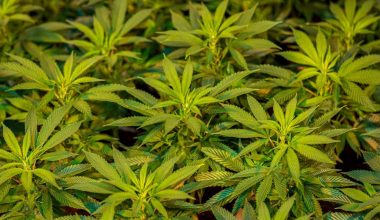California cannabis farmers growing their plants under the sun said the weather cooperated during the 2024 growing season.
A cold, wet spring followed by a hot, dry summer with fewer wildfires combined to improve yields – and, potentially, prices.
Sun-grown marijuana is celebrated for its rich terpene profiles and earthy, distinct aromas, which enthusiasts often describe as more natural or complex than indoor-grown strains.
“For Emerald Triangle farmers, this could be the best harvest season I’ve ever seen,” said John Casali, who grew up growing cannabis on Huckleberry Hill Farms in Humboldt County.
Humboldt, Mendocino and Trinity counties form California’s famed Emerald Triangle.
Sol Spirit Farm co-founder Judi Nelson told MJBizDaily that the weather delayed spring planting, so she was still bringing in the last of the “Croptober” harvest in Trinity County.
Nelson said planting and harvesting late is a double-edged sword: The moisture from spring rains kept wildfires at bay, but a later harvest could put the crop at risk for mold as California enters its rainy season.
“That’s always a little nerve-racking because it starts to rain and you get mold,” Nelson said, noting that the cultivars still left in the ground last week were mold resistant.
“It was a really nice summer for us.
“We’ve had fires around us for the past four years … this is the first year in a while that we haven’t been impacted by smoke.”
Premium flower, premium price
Sol Spirit flower is sold almost exclusively in the farm’s branded, compostable packaging, an endeavor Nelson admits is a lot of work but worth the effort to control pricing and tell the brand’s story.
Sol Spirit’s plants are certified regenerative, which allows the company to price its flower higher than some other brands.
“There are tiers to sun-grown just like any other product,” Nelson said.
“There’s mass-produced, there’s the mids and then top shelf, which is most of what is coming out of the Emerald Triangle.
“We’re all small, craft farms, so our quality is the very top tier of sun grown.”
Nelson said she’s able to sell Sol Spirit flower for as much as 3.5 times more than the lowest tier of mass-produced flower because people recognize the quality and the time the company puts into its product.
Marijuana sales agreements
Like most California craft marijuana growers, Sol Spirit Farm does not have contracts in place for its branded products.
“I have dispensaries that have supported my brand since 2018; they are loyal to me, and their customers have developed an affinity for my brand,” Nelson said.
“Those dispensaries will continue to buy from me for as long as my quality stands up.”
Nelson also sells cannabis in bulk to Solful, a Bay Area retail chain that packages it as its own brand.
Manufacturers who want specific, sought-after genetics – such as Huckleberry Hill Farms’ award-winning Whitethorn Rose – likely have contracts in place because customers line up for the products.
My Green Network and Ay Papi purchased Huckleberry Hills’ entire crop before the harvest began, Casali said.
“The only way forward for small farmers is with legacy genetics,” he added.
“With Whitethorn Rose, we’ve had huge demand to share this cultivar with manufacturers, distributors or farmers; 2026 will be the first time it’s released to the public, and we’ll be doing licensing agreements.”
Demand for clean marijuana
Nelson said the pesticide scandal that surfaced in California this year has reignited consumer interest in sun-grown cannabis from craft farms, and she expects prices for craft flower will start to climb as well.
“I anticipate we’re going to see a higher demand for products like ours because they’re rare and becoming more rare as our neighbors have to drop out of the market,” Nelson said.
“Consumers are more aware of quality; they feel better, and they want to make sure what they’re getting is clean.”
All-natural cannabis pest management
After learning about research that determined even organic pesticides are harmful when heated up, Carpinteria-based Autumn Brands eliminated all pesticides from its 5½-acre greenhouse cultivation operations.
The company also threw away tens of thousands of marijuana plants valued at hundreds of thousands of dollars and transitioned to an integrated pest-management system using ladybugs native to California to eliminate pests.
“It took a number of years to get that dialed in, and after seven years, we have the perfect ecosystem,” said Autumn Shelton, the company’s chief financial officer and a partner in the business.
“You can wash your fruits and vegetables, but you can’t wash your weed.”
The climate between the ocean and the mountains, where Autumn Brands’ farm is located, is perfect for growing cannabis, Shelton said.
“We still get natural sunlight, and we can protect the plants from the elements.”
Fewer wildfires in 2024
While some of California’s marijuana farmers were close to wildfires, the overall threat was less severe this year, allowing farmers to focus on their crops.
The reprieve from the devastating fires of previous years provided a much-needed boost to the industry.
Amaranth Farms in Humboldt County also has benefitted from its location near the Pacific coast, which is far enough away from national forest land to have a buffer from wildfires.
“If you’re inland, you border some of it, and it can be really detrimental,” said Nya Hessler, whose family has operated Amaranth Farms since the 1970s.
2024 MJBiz Factbook – now available!
Exclusive industry data and analysis to help you make informed business decisions and avoid costly missteps. All the facts, none of the hype.
Featured inside:
- Financial forecasts + capital investment trends
- 200+ pages and 49 charts highlighting key data figures and sales trends
- State-by-state guide to regulations, taxes & market opportunities
- Monthly and quarterly updates, with new data & insights
- And more!
Price for outdoor cannabis
Although Hessler expects an abundance of sun-grown marijuana will flood the market this year, he is hopeful that small, craft cannabis flower will bring in about $500 per pound.
“That keeps everybody in business,” he said.
“About 90% of the businesses are gone; Humboldt County started with 1,200 farms, and I think we’re down to 250 farms.”
Louis Samuel, CEO of licensed marijuana delivery company Golden State Cannabis, said many Humboldt County farmers slowed production after large, multistate operators entered the market, causing prices to tank.
But when prices hit $500 in 2023, Emerald Triangle growers started planting again, forcing prices back down to $300 to $350, a level that Samuel says doesn’t allow farmers to feed their families or pay a mortgage.
Even so, Samuel said there’s a renewed sense of optimism among craft marijuana farmers.
“This year, the prices dropped way down low, but you don’t feel the same sense of depression as in ’21,” Samuel said.
“It’s just acceptance – ‘this is my last year and I’m out’ – or a sense of resilience for people who have dialed in their process and expenses.”
Margaret Jackson can be reached at margaret.jackson@mjbizdaily.com.
Medical Disclaimer:
The information provided in these blog posts is intended for general informational and educational purposes only. It is not a substitute for professional medical advice, diagnosis, or treatment. Always seek the advice of your physician or other qualified healthcare provider with any questions you may have regarding a medical condition. The use of any information provided in these blog posts is solely at your own risk. The authors and the website do not recommend or endorse any specific products, treatments, or procedures mentioned. Reliance on any information in these blog posts is solely at your own discretion.






